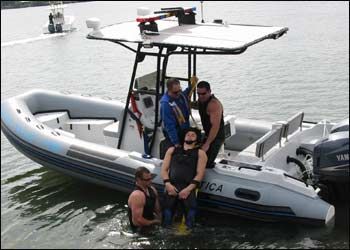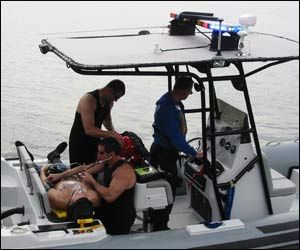FireRescue1 Staff
Imagine a town with hundreds of roads but no emergency response vehicles. Where patients have to drive to paramedics — and paramedics are forced to stand around, kicking the curb while they wait to administer care. That’s what the EMS professionals in the village of Tequesta, Fla., experienced every time they got a call.
 PHOTO COURTESY OF TEQUESTA FIRE/RESCUE Tequesta, Fla., paramedics use a “victim” to train for open water rescue. |
Tequesta is not a large town. It contains a grand total of two square miles within its city limits, but like most Florida towns, it does have a lot of water. Thirteen miles of shoreline, including three rivers that run through the center of town, means more water than roadways for residents. Everyone has a boat, except for — until recently — the people who were needed on the water most: the paramedics. However, it wasn’t until Hurricane Katrina slammed through the levies of New Orleans that Palm Beach County officials realized they might need extra emergency reinforcements on the water in their neck of the woods.
To address this need, in November Tequesta-Fire Rescue purchased a brand new 22' rigid hull inflatable Nautica rescue boat. With the boat, said Tequesta Fire-Rescue’s spokesperson Peter Allen, paramedics no longer have to wait on the docks for a diver suffering from Nitrogen poisoning to come to them.
“Now, we can take the services out to the patients,” Allen said. “That’s the concept behind EMS. Having this boat is a natural extension of what we do.”
The boat purchased by Tequesta is one of a number of designs Nautica provides for fire and rescue personnel all across the country – from Florida to Connecticut, North Carolina and Georgia. During the manufacturing process, Tequesta emergency teams worked closely with the company, visiting their boat on site to ensure the craft would have the right specs. While some rescue boats may be earmarked for one department, the Tequesta boat had to fit the bill for two agencies; both Tequesta Fire-Rescue and the Tequesta Police Department use the boat for patrolling and rescue operations.
“This boat is the best compromise between the needs of two agencies,” Allen said.
One feature of special importance for both parties is the boat’s rigid inflatable hull. In areas of high surf, the inflatable sides prevent the vessel from getting swamped or tipping. Another key feature is the presence of a double engine, so that if one fails, the boat will remain operational. Also, the boat is light enough to be hoisted by a boat lift and has a spacious deck for a patient of any size to fit comfortably. Allen also says the inflatable sides will help if the crew needs to come alongside another boat; the pontoons minimize the chances of damaging either the rescue boat or that of the patient.
 PHOTO COURTESY OF TEQUESTA FIRE/RESCUE After securing their patient to the back seat of the rescue boat, Tequesta paramedics are able to administer care and safely transport an injured diver or boater. |
One of the main response areas for the Tequesta crew is the Jupiter inlet, which is one of the most dangerous in the county — and perhaps the nation — according to Allen. While the inlet will no doubt be a safety challenge for the paramedics on board, the bigger challenge may be the calls these emergency personnel will respond to.
“Our response time from the station to the inlet is less than 10 minutes,” Allen said. “We run the gamut of calls. Everything from alligator attacks to fights, Jet Ski collisions, diving accidents, fishing accidents and people lost at sea.”
The team also responds to calls involving any one of the three Tequesta rivers, which adds auto accidents to the list, as drivers sometimes veer off the road and into the waters below.
Since the Tequesta paramedics are called to the scene of a wide range of situations, they have to have the equipment to handle it all - and it all has to be water proof. A general list may include a manual/auto defibrillator, a pelican case with meds, airway and trauma equipment, a miller board, dive gear and a small mobile fire pump.
However, due to the storage limitations of the boat, they’re unable to take along all the equipment in the locker. Nor can they take along the whole team. Typically, Allen says, there will be one pilot and one paramedic or EMT on board the craft.
So far, Tequesta Fire-Rescue has between six and nine individuals lined up to crew the new rescue boat. To gain a spot on the team, crew members must be experienced boaters and have a minimum status of EMT-firefighter. They must also take part in a 40-hour intensive training regimen in the Jupiter inlet. There, members are schooled in a number of skills, including equipment use, navigation, launching, open ocean safety, dive support, and towing and re-righting other vessels. The inlet training course is provided by Marine Rescue Consultants out of Newport Beach, Calif., a company that trains agencies (government and non-governmental) all over the nation in water rescue.
After all the time and preparation, not to mention the financing hurdles in finding the money to buy the shiny new boat, Allen says the rescue boat fills a basic need.
“Every EMS agency needs to look at their community and ask ‘how can we expand and improve our offerings? Where is our risk?’” Allen said. “We’re right on the water and there were calls and injuries.”
Discuss this story in the Columns and Exclusives section of FireRescue1 Forums











